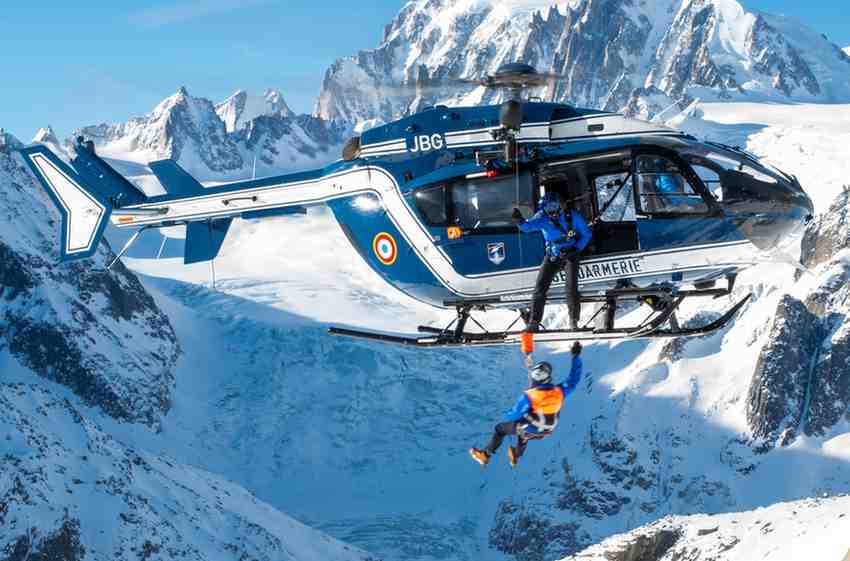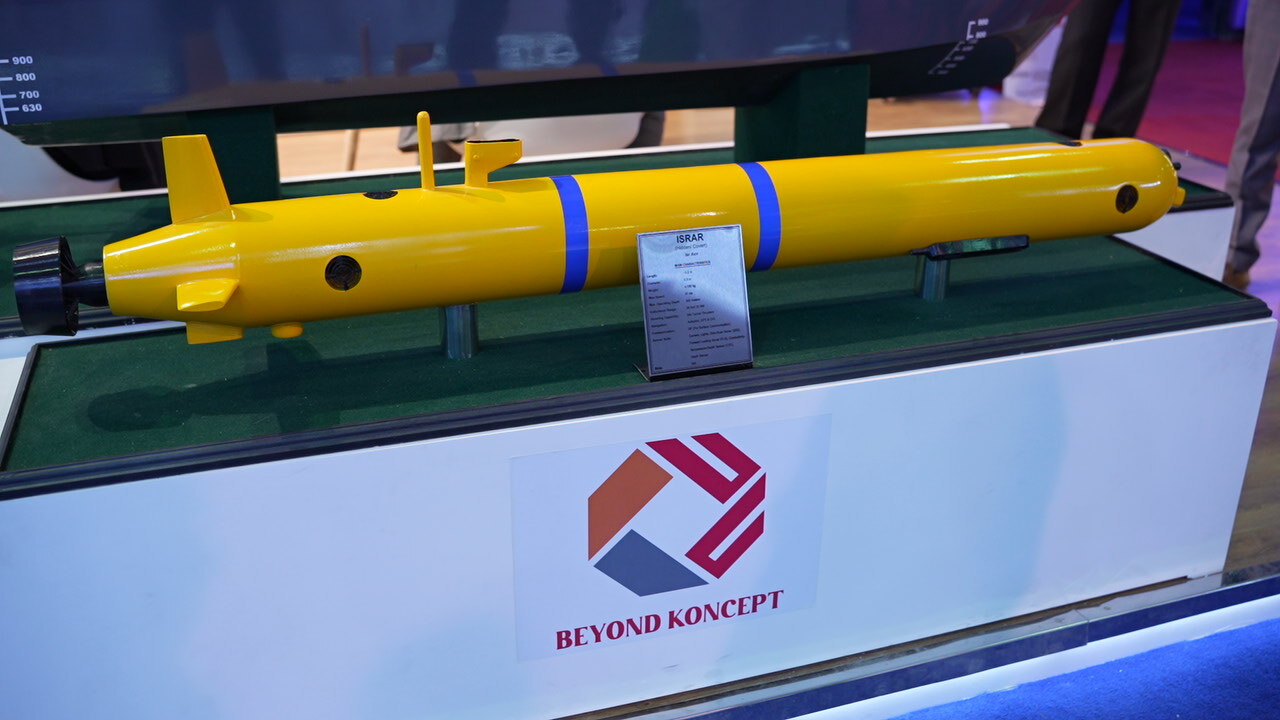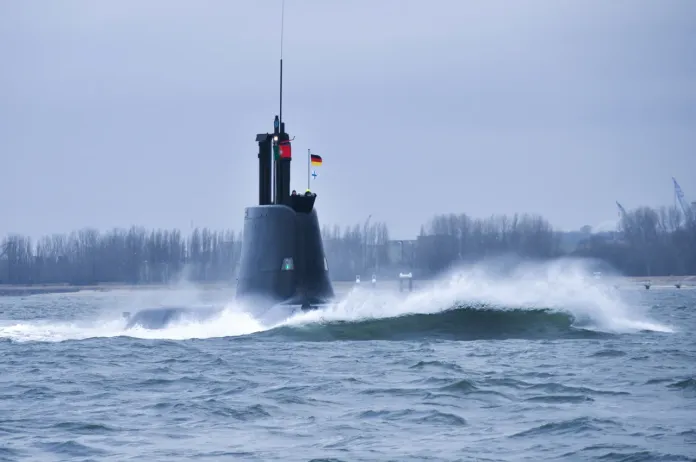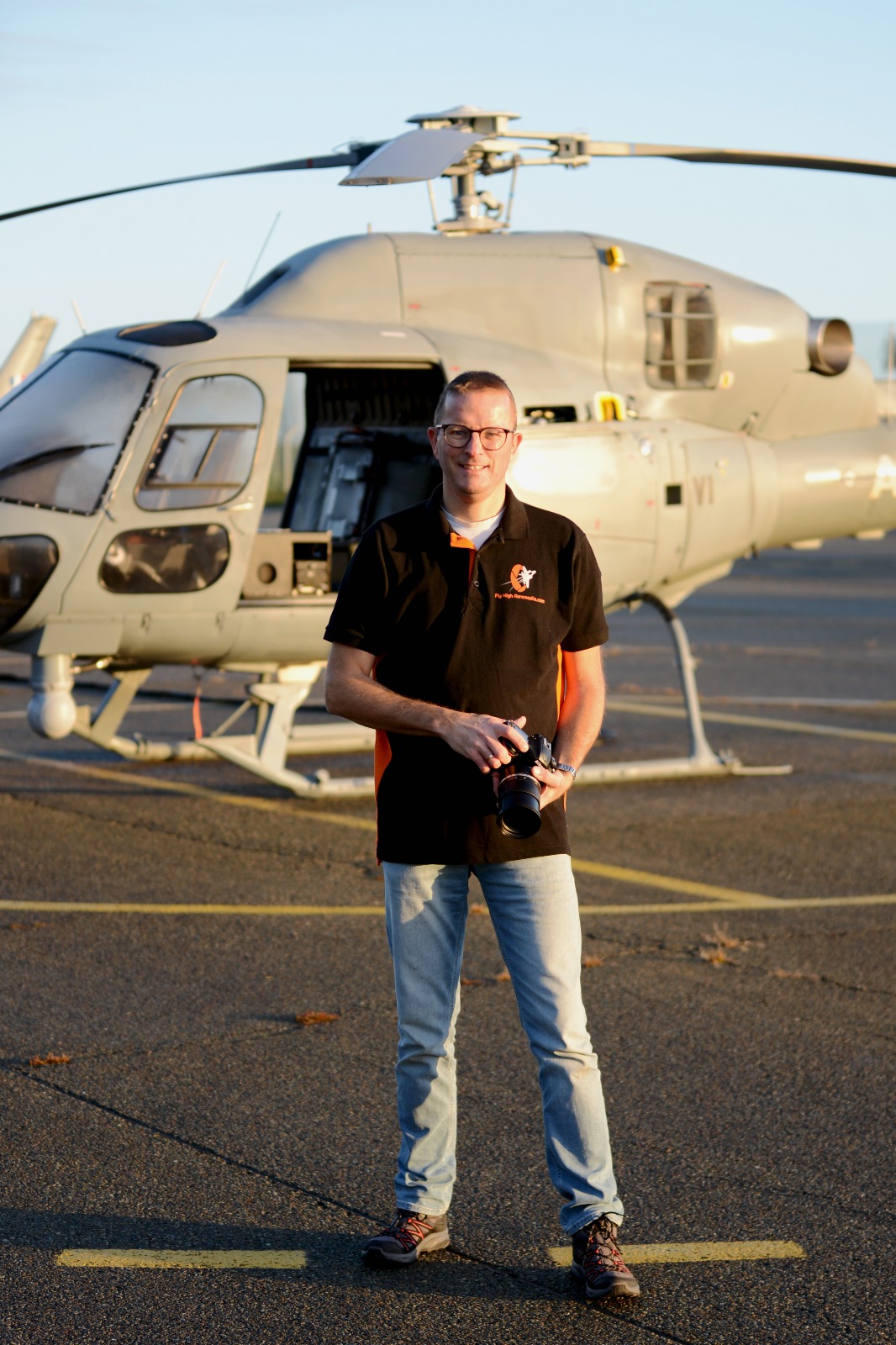Nestled in the heart of the French Alps, the Gendarmerie Air Section (SAG) of Chamonix stands as a lifeline for those who dare to venture into the treacherous beauty of the Mont Blanc massif. Working in seamless coordination with the Peloton de Gendarmerie de Haute Montagne (PGHM), a specialized high-mountain rescue unit, these airborne heroes ensure that mountaineers, skiers, and hikers receive swift and expert assistance when danger strikes. But what is behind these operations? Roelof-Jan Gort visited the SAG Chamonix and spoke with Captain Herman, who has been Squadron Leader since 2019 and a pilot at the FAGN since 2005. As a qualified pilot on the AS350 Écureuil and the EC145 he has over 4700 flight hours.
This morning, Captain Herman, the Commander and squadron leader of the Gendarmerie Air Section in Chamonix, is sitting at his desk with a view of the platform where EC145 is being prepared by the ground crew behind him. In the background, the mountains are gradually becoming visible as the mist clears. “It’s going to be a busy day today with various training missions, and we may also have some additional rescue missions to carry out,” says Commander Herman as he reviews today’s schedule.
As Commander of the SAG Chamonix section, Captain Herman is responsible for flight safety, effective management of technical resources, operational response, and crew preservation. Chamonix SAG offers a 24/7 alert system that includes a pilot, an on-board mechanic, and additional radio alert personnel. SAG Chamonix employs three pilots, four winch-on-board mechanics, and one aero surveillance operator, in addition to office staff.
The assignment to SAG in Chamonix is based on volunteer participation. It is not possible to assign personnel who are not volunteers due to the technical demands and commitment required for this role. Additionally, candidates typically need to have served at one or two other mountain bases before being eligible for assignment in Chamonix to ensure they have sufficient experience.
A Legacy of Aerial Rescue
The need for specialized mountain rescue services in France became evident in the mid-20th century as alpine tourism and mountaineering gained popularity. The treacherous conditions of the high mountains necessitated a dedicated force trained to manage emergencies in such environments.
The history of aerial rescue in the Gendarmerie dates to May 6, 1954, when France set up its first airborne unit, ushering in a new era of mountain rescue. Just three years later, in 1957, the introduction of the Alouette II helicopter revolutionized high-altitude operations, providing rescuers with the ability to reach climbers stranded on sheer rock faces or deep within icy crevasses.
In response to this need, the PGHM was established in 1958, focusing on mountain rescue operations. Recognizing the importance of aerial support in such missions, the Gendarmerie Air Section in Chamonix was subsequently formed. This collaboration between ground and air units revolutionized mountain rescue operations, allowing for quicker response times and more efficient rescues.
As technology advanced, so did the Gendarmerie’s fleet. The AS350B Écureuil, introduced in 1978, brought increased agility and power, while the EC145, added in 2002, became the ultimate workhorse for high-altitude rescues. These state-of-the-art helicopters, equipped with advanced medical and rescue gear, allow SAG to execute missions in some of the most challenging conditions on Earth. These aircraft are equipped with specialized gear such as winches, stretchers, and navigation systems tailored for mountain operations.
A Highly Trained, Elite Team
Operating in the extreme environment of the Mont Blanc region requires skill, precision, and courage. The SAG of Chamonix consists of eight elite military personnel, including highly trained pilots and expert winch operators. These professionals undergo rigorous training, often boasting years of experience in both military aviation and mountain flying.
Mechanics in the unit serve dual roles, not only ensuring that the aircraft stay in peak condition but also acting as in-flight winch operators, lowering rescuers into perilous situations where every second counts. Their ability is critical when evacuating injured climbers from near-vertical rock faces or extracting skiers caught in avalanches.
To get more information about the pilot training and mountain training within the FAGN, Roelof-Jan asked Captain Herman about the pilot training at the FAGN (Forces Aèriennes de la Gendarmerie Nationale). He explained: “The pilot training in the FAGN begins with an 18-month basic training course in the Army’s aircraft school based in DAX to obtain a pilot’s license. It continues with five to six weeks of additional training at CNIFAG to obtain the qualifications required for the gendarmerie (winching, camera, type qualification, etc.)
He continued:” Then assigned to a unit, the young pilot will have to continue his training by completing around fifty hours of operational flight in dual control. He will then be released on a mission. If he wishes to become a mountain pilot, he will have to, after a detection phase, confirm a mountain flight qualification provided in four 2-week courses spread over the 4 seasons. This training is given at the Mountain Flying Training Center in Briançon, which is also situated in the French Alps, but more to the South.
The Role of the CNISAG
Central to the effectiveness of the PGHM and SAG is the Centre National d’Instruction de Ski et d’Alpinisme de la Gendarmerie (CNISAG), located in Chamonix. Established in 1988, CNISAG is responsible for training gendarmes in mountain operations, including skiing, alpinism, and aerial rescue techniques. The rigorous training ensures that personnel are well-prepared for the challenges of high-altitude rescues.
The PGHM and SAG units are composed of highly trained professionals, including mountain guides, pilots, flight engineers, and rescue specialists. Their combined expertise allows for seamless coordination during complex rescue missions.
Rescue Missions
The primary mission of the SAG in Chamonix is to conduct aerial rescues in the Mont Blanc massif and surrounding areas. These missions often involve evacuating injured climbers, skiers, or hikers from inaccessible locations. The unit operates year-round, with increased activity during peak tourist seasons. Beyond rescue operations, SAG also assists in law enforcement activities, including surveillance of protected areas, monitoring of illegal activities, and support during major events in the region. The SAG often collaborates with other emergency services, including the Sécurité Civile and medical teams, to ensure comprehensive response capabilities during emergencies.
Roelof-Jan Asked Captain Herman about these rescue missions they perform. He explained how the rescue missions take place at the SAG: “Mountain rescue missions are conducted under the authority of the PGHM, which determines the necessary resources for each operation. If a helicopter is deemed the most effective option, the PGHM coordinates with SAG for assistance. During the day, the helicopter can be airborne in just a few minutes, while at night, a delay of approximately 40 minutes is typical. We can respond anywhere in the territory, both day and night, and at all altitudes. The only limitations we face are adverse weather conditions, such as intense winds, clouds, fog, and snow”.
And to conduct these rescue missions successfully they need a crew made up of a pilot and a winch mechanic. They have equipment to perform each type of rescue mission like a camera, Night Vision Goggles (NVGs), thermal binoculars, searchlight, winch, etc. Depending on the type of mission they can take rescuers, doctors, investigators, intervention teams (GIGN) with them. They only take off at night for verified life-threatening emergencies and with stricter weather conditions than during the day.
Captain Herman explains what a rescue team consists of and the tasks these individuals perform: ”A rescue team typically consists of five members: a pilot, a winch operator, two PGHM rescuers, and a doctor. This configuration can be adjusted based on the specific type of rescue. For instance, in an avalanche situation, it may be necessary to quickly deploy more rescuers during the search phase. The doctor might only become involved in the second or third rotation. Each member of the team has a specific role. The crew’s mission is to transport the rescue team to and from the scene of the incident. To conduct this mission, they must hold a mountain qualification issued by the gendarmerie.
Captain Herman continues:”The personnel from the PGHM (Peloton de Gendarmerie de Haute Montagne) are trained first aiders, judicial police officers, and high mountain guides, and they are responsible for conducting the rescue operations. Additionally, the doctor is an emergency physician who can work independently in mountainous and high-altitude environments, and he or she oversees making medical decisions. About the clothing, the following. We carry a survival kit in case we get stranded in the mountains. To prepare for this, we undergo all mountain survival training. We are equipped with clothing suitable for the environment, which allows us to move comfortably and protects us from the cold”.
The helicopters are equipped with skis, winches, and an aluminum floor. This setup allows for climbing with crampons and includes rescue and survival equipment. Their performance is consistent, but working at high altitudes necessitates taking off at a light weight. Therefore, we only carry the equipment, personnel, and fuel that are strictly necessary to maintain this lightness.
Swift Response in the Face of Tragedy
The SAG’s work is more than just technical ability—it is a mission of life and death. On April 9, 2023, the SAG was instrumental in responding to a massive avalanche on the Armancette Glacier, which tragically claimed several lives. The swift action and coordination between aerial and ground units highlighted the critical role of the SAG in managing large-scale mountain emergencies. Their rapid response allowed rescuers to reach survivors trapped beneath tons of snow, showing the vital role of aerial intervention in mountain emergencies. Beyond rescue missions, the unit is also instrumental in medical evacuations, law enforcement support, and high-risk interventions, ensuring that no corner of the Mont Blanc massif is beyond reach.
The Lifeline of the Mont Blanc Massif
With over 60 years of experience in mountain rescue, the Gendarmerie Air Section of Chamonix is more than just a unit and is a symbol of dedication, skill, and heroism. Their presence enhances the region’s safety, giving adventurers the confidence to explore the majestic yet unforgiving landscapes of Mont Blanc.
Whether soaring through stormy skies or hovering inches above a frozen peak, these airborne rescuers embody the spirit of mountain rescue, proving that when disaster strikes, help is never far away.
Routine Rescues
The SAG conducts numerous rescues annually, ranging from assisting injured hikers to evacuating stranded climbers. For instance, in August 2022, the unit conducted multiple operations, including rescuing paragliders and elderly hikers, showcasing their versatility and readiness.
Increasing Tourist Activity
With the growing popularity of mountain tourism, SAG faces the challenge of managing an increasing number of rescue operations. Ensuring the safety of both tourists and residents requires continuous training and resource allocation. The SAG is continually updating its equipment and training protocols to incorporate the latest technological advancements, ensuring that they remain at the forefront of mountain rescue operations.
Future Outlook
The Gendarmerie Air Section of Chamonix stands as a testament to France’s commitment to mountain safety and rescue excellence. Through rigorous training, advanced equipment, and unwavering dedication, the SAG continues to safeguard the lives of those who explore the majestic yet perilous terrains of the French Alps.
Captain Herman about the future expectations of the SAG Chamonix: “First I want to continue to thrive at SAG in Chamonix and prepare for the arrival of the next helicopter scheduled for 2026 (H145D3). This is another positive advancement with a helicopter that is in many ways superior to the current EC145. Next to this the technological evolution of helicopters and climate change are the primary factors that will impact our profession. Climate change leads to issues such as landslides, melting glaciers, and rising temperatures, all of which affect our performance and introduce new dangers. We rely on manufacturers to provide us with innovative technologies that will help us maintain a high level of flight safety while carrying out our missions. Therefore, FAGN must adapt to these changes by continuing to develop its equipment, ensuring that we excel in this challenging environment, just as we have for the past 60 years”.
Roelof-Jan Gort would like to thank Captain Allerme from the Headquarters at BA107 Villacoublay and Captain Herman from the Gendarmerie Air Section Chamonix for making this article possible.

Roelof-Jan Gort
Roelof-Jan Gort, a Dutch photographer based in the heart of the Netherlands, has been capturing the world of military aviation across Europe since the 1990s. He is the co-founder of FlyHighAeromedia.com, where for over five years he has co-authored numerous articles on military exercises and both military and civilian helicopters, published internationally — including this feature on the Section aérienne de gendarmerie (SAG) de Chamonix-Mont-Blanc.
- This author does not have any more posts.












